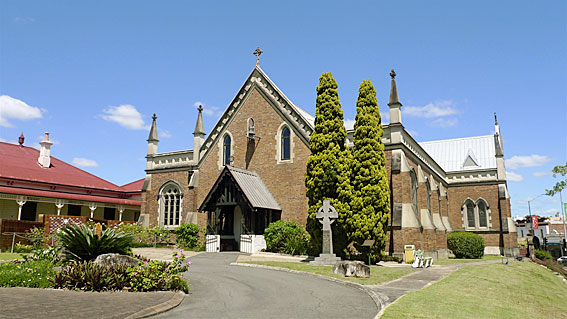
St Paul's Anglican Church, Ipswich
[Photograph by Trevor Bunning (November 2011)]

St Paul's Anglican Church, Ipswich
[Photograph by Trevor Bunning (November 2011)]
Historical and Technical Documentation by Geoffrey Cox
© OHTA 2012, 2016 (last updated December 2016)
St Paul's Church was opened on Whitsunday, 12 June 1859, having been built to the design of the Sydney architect Edmund Thomas Blacket, though supervised by William C. Wakeling, who moved north for the purpose. The building was consecrated by Bishop Hale on St Mark's Day, 25 April 1880, and the side aisles were added in 1888 to the design of F.D.G. Stanley.1 A new sanctuary, chancel, chapel and aisles were added in 1929 to mark the 70th anniversary of the opening of the church.2
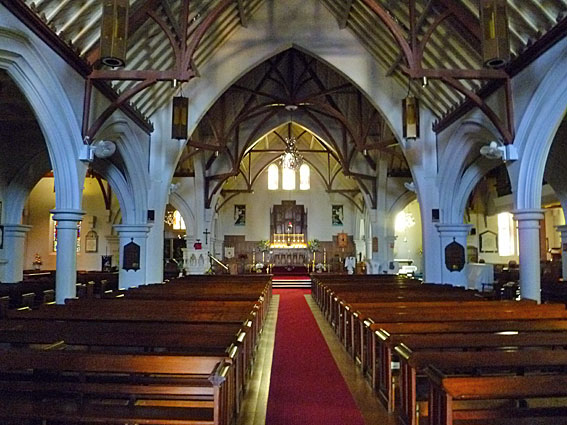
The interior of the enlarged church
[Photograph by David Vann (September 2012)]
It has long been believed that the organ in St Paul's Church was the first in the newly established colony of Queensland. This now appears not to be true, as an earlier chamber organ had existed in Brisbane at 'Dara', the residence of W.A. Duncan, Fortitude Valley. The organ at St Paul's, Ipswich, was nevertheless the first organ installed in a church in Queensland.
By the time the colony of Queensland was proclaimed independent of New South Wales on 10 December 1859, the organ for St Paul's had been ordered, and it was shipped from London early in the following year, bound for 'Ipswich Church, Moreton Bay'. The Ipswich Herald reported that the parishioners met on Tuesday 25 October 1859, just four months after the opening of the church, when they were informed by the incumbent, Rev. Lacy H. Ramsey, that an organ had already been ordered for the building they now so proudly occupied. This, it was reported, had been made possible by 'the kind liberality of two gentlemen of the congregation' and it was stated that 'one of the most eminent organists of England had kindly undertaken to superintend the building of the instrument.'3
In December that year, the same press carried a congratulatory notice concerning the acquisition of the organ, and the donors were clearly identified:
We beg to felicitate Ipswich on being the first of our Queensland towns to possess so useful and beautiful an appendage to her no less beautiful church; and, in so doing, we may express a hope that she has but set an example which her sister towns and the city of Brisbane will shortly follow... It may be stated that the organ was the seasonable and munificent donation of Messrs Thomas de Lacy Moffatt and Thomas Bell.4
The organ had been ordered from the well established firm of J.W. Walker, London, who had supplied instruments for several other locations in Australia from 1849 onwards.5 An annotation to the relevant entry in the Walker ledger records that the organ for Ipswich was shipped on 24 February 1860 - "per 'Berengaria' for Sydney - cases marked T. de Lacy Moffatt, Ipswich, Moreton Bay. To the care of Messrs R. & F. Tooth, Sydney". It was also noted that the London agents were Tooth & Mort of 155 Fenchurch St., and that the organ was built under the supervision of Dr E.J. Hopkins, Organist of the Temple Church in London. It was listed as Job No 649.6

The 1860 Donors' Plate
[Photograph by Peter Robinson (March 2015)]
The plate commemorating the two original donors of the organ survives on the present organ. The Hon. Thomas de Lacy Moffatt and his father-in-law [Sir] Thomas Bell, were prominent public figures at the time.7 The name of Thomas Bell's son, [later Sir] Joshua Peter Bell, appears at the head of the relevant ledger entry for the organ in the records of J.W. Walker, where the full specification and details of the organ are given:8
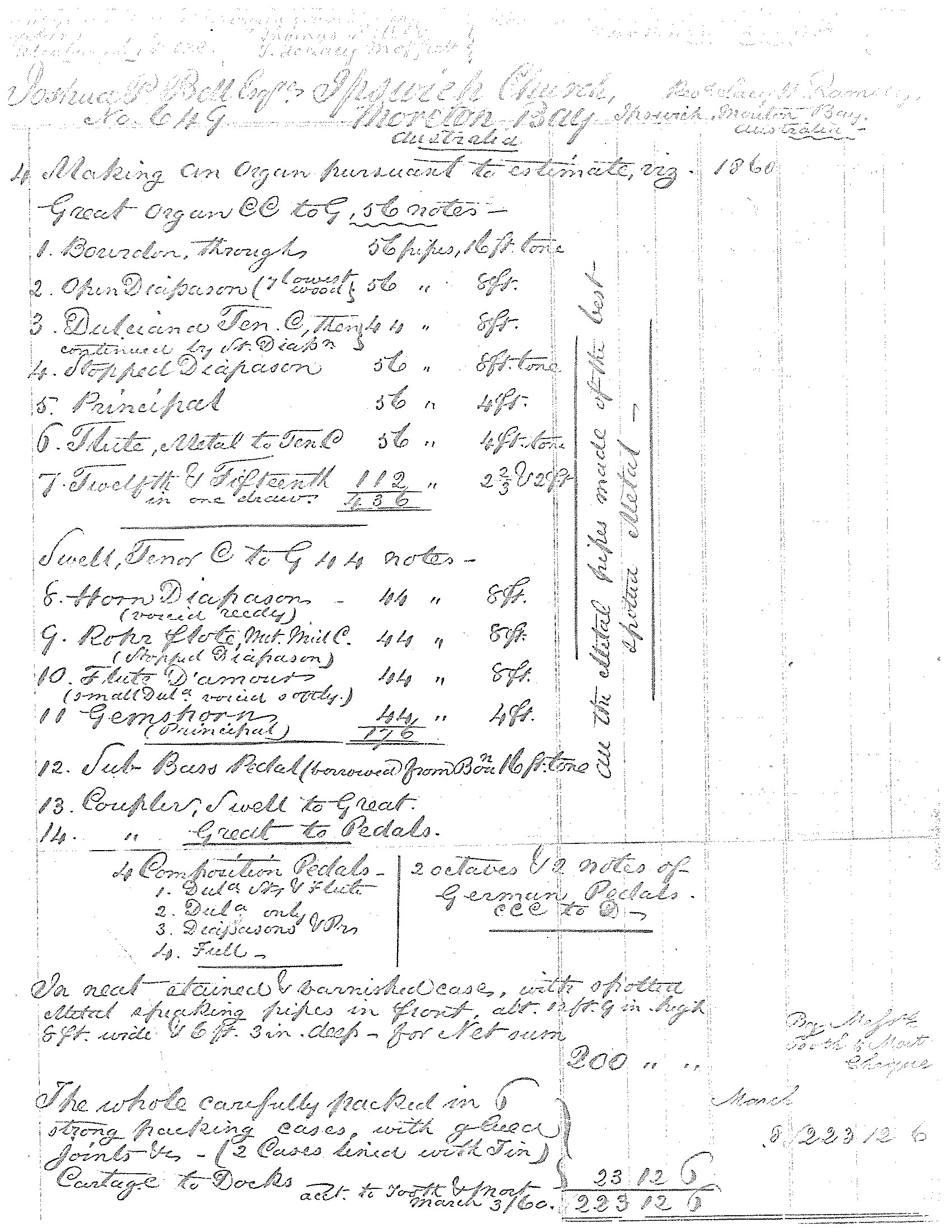
J.W. Walker Ledger Book AA (1852-62), p. 368
[J.W. Walker & Sons Ltd, Brandon, Suffolk]
There has been a persistent myth that the organ was erected originally in the gallery,9 but a newspaper report of the time confirms that it was originally placed on a platform near the eastern door:
The Ipswich Herald has the following: "Our readers will be pleased to learn that the costly organ for St. Paul's Church - the gift of Messrs. Moffat and Bell - has arrived in Sydney per Berengaria, and is expected in Ipswich by the next or following steamer. It has been decided to dispense altogether with an organ gallery; instead of which the organ will be placed on a platform ruined about three feet from the floor, and near to the eastern door of the church."10
It was not until 1882 that it was moved to the gallery, which was newly constructed at the time.11 With the addition of side aisles to the church, however, the organ was moved from the gallery to the north (left) transept in 1888, at which time the choir was also re-located to the chancel. New choir stalls were eventually provided in the chancel in 1894.12
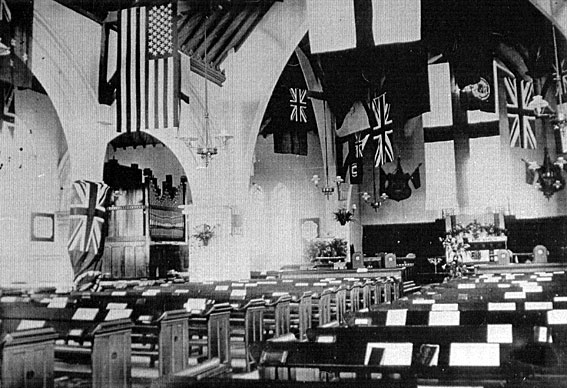
St Paul's Anglican Church, Ipswich, in 1902,
decorated to celebrate the coronation of King Edward VII
[Photograph by courtesy of Miss Ivy Roberts,
published in The Organ Voice, vol. 19, no. 5 (April 1992)]
The new instrument attracted much interest in the early years after its arrival, and was reportedly played sometimes until very late at night. This was much to the annoyance of at least one member of the Ipswich Church Society, who complained at a meeting in 1863:
A person in the body of the meeting asked by whose authority the organ of St. Paul's was often played till 10 or 11 on a Sunday night, and for an answer he was referred to the churchwardens, before whom he was directed to lay a formal complaint. The question of continuing the use of the organ was introduced, but no definite conclusion was come to.13
The organ was significantly enlarged in 1897, when Whitehouse and Marlor of Brisbane rebuilt the Swell Organ, completing the compass down to bottom C (56 notes), and providing a new soundboard and a new swell box. When the instrument was re-opened on 15 September 1897, The Queensland Times reported that two new stops (Cornopean 8ft and Oboe 8ft) had been added to the Swell, and that there was preparation for further additions:
THE ORGAN AT ST PAUL'S, IPSWICH.
With reference to the improvements which have been carried out by Messrs. Whitehouse and Marlor, of Brisbane, we learn that the organ is to be opened at a special festal evensong on Wednesday next, September 15, at 7.30, when the Archdeacon of Brisbane will give an address. The anthem will be "The Heavens are Telling." On the old organ there were six stops on the great, four on the swell, one pedal stop, a great to pedals, swell to great. The tenor C swell is now completed and carried to bottom C. New stops have been procured from England, oboe and cornopean, while piccolo and vox celesti are prepared for. New sound-boards and new swell-box have been made, the bellows are enlarged, and the whole of the mechanism adjusted. Consequently, the congregation on Wednesday evening next may expect to hear a much-improved organ.14
A hydraulic motor appears to have been added at this time. At Easter 1898 it was described as having been 'placed outside the church', and it continued to cause trouble and expense for some years to come.15
Mr R. Henderson Johnston, who was the church organist from 1893 to 1931,16 reported as follows in the St Paul's Monthly Paper (February 1903):
… our organ possesses one of the finest great organs I have ever heard in an instrument of this size; but the swell organ, to save expense, was very limited, and it is here that the enlargement scheme, commenced about three years ago and finished now, is carried out. This involved a new swell box, fittings and action complete, also the addition of more stops, and the swell box now contains 400 pipes, from 8ft. to half-an-inch speaking length. With the new stops just put in place – viz., Piccolo and Salcional [sic.] (100 pipes) – and the conversion of an old set of pipes into a Voix Celeste, we have a complete swell organ, which forms a proper balance of tone to the great organ …17
The original 'Flute D'amour', which was described in the Walker Ledger as a 'small Dulciana voiced softly', had apparently been renamed 'Voix Celeste' by November 1897, when it was mentioned in the review of a recital at St Paul's by Seymour Dicker.18 Given that the original Tenor C Swell contained only four stops each of 44 notes, totalling 176 pipes, it can be deduced that, to total 400 pipes by 1903, the Swell must by then have contained 8 stops as follows:19
| SWELL Horn Diapason Rohr flote Salicional Voix Celeste Gemshorn Piccolo Cornopean Oboe |
44 pipes 56 pipes 44 pipes 44 pipes 56 pipes 56 pipes 56 pipes 44 pipes ________ Total: 400 pipes |
[gvd bass] [gvd bass] |
8 ft 8 ft 8 ft 8 ft 4 ft 2 ft 8 ft 8 ft |
[1860] [1860; bass octave 1897?] (Stopped Diapason) [1903] [1860; formerly "Flute D'amour", renamed 1897] [1860; bass octave 1897?] [1903] [1897] [1897] |
A new tremulant was supplied by B.B. Whitehouse & Co. in July 1907.20
The most far-reaching alterations to the organ occurred in 1912-14, when it was completely rebuilt by B.B. Whitehouse & Co. of Brisbane, using tubular-pneumatic action and new slideless soundboards. Proposals to rebuild the instrument were approved by the Easter Vestry in 1912. The scheme involved total replacement of the mechanism, a new console, provision for future additions, and 'a complete set of pedal pipes of proper weight.'21 The rebuilt organ was opened on 27 August 1914, with a new three-manual detached stop-key reverse console, and the manual compass extended to 61 notes. There was much preparation for further additions, particularly on the Choir & Solo manual, but 18 of the proposed 26 stops were already in place by this time:
| GREAT Bourdon Open Diapason Stop Diapason Dulciana Principal Lieblich Flute Twelfth Fifteenth |
16 8 8 8 4 4 2-2/3 2 |
[1860] [1860] [1914] [1860] [1860] [1860] [1860] [1860] |
|
| SWELL Diapason Voix Celeste Flute D'Amour Lieblich Gedact Gemshorn Piccolo Cornopean Oboe |
8 8 8 8 4 2 8 8 |
[1860] [1860; formerly 'Flute D'amour] [1903; formerly 'Salicional'] [1860; formerly 'Rohr flote'; bass octave 1897?] [1860; bass octave 1897?] [1903] [1897] [1897] |
|
| CHOIR & SOLO [Dulciana] Lieblich Gedact [Flute] [Orchestral Oboe] [Tuba] [Clarinet] |
[8] 8 [4] [8] [8] [8] |
[prepared for] [1860, ex Great] [prepared for] [prepared for] [prepared for] [prepared for] |
|
| PEDAL [Open Diapason] Bourdon [Violoncello] [Trombone] |
[16] 16 [8] [8] |
[prepared for] [1914] [prepared for] [prepared for] |
|
| COUPLERS Swell to Great Swell to Choir Choir to Great Swell to Pedals Choir to Pedals Great to Pedals Swell Superoctave Swell Suboctave |
Detached stop-key console
Radiating concave pedalboard
3 thumb pistons & 1 release to Great Organ
3 thumb pistons & 1 release to Swell Organ
Compass: 61/30
Balanced swell pedal
Pneumatic action.22
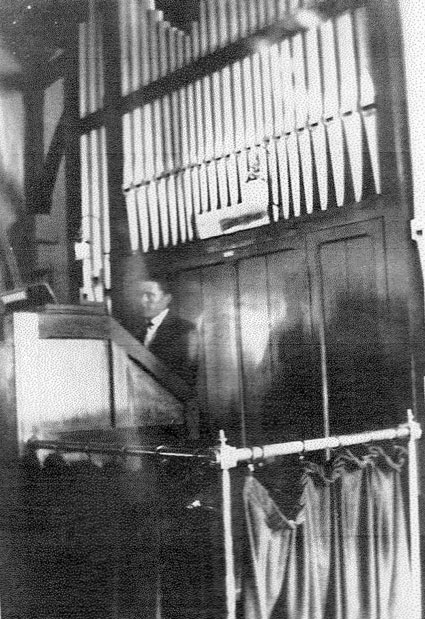
The new detached reverse console of 1914,
with the organ still in the north transept (January 1924)
[Photograph supplied by Ruth Mullan (November 2012)]
All of the original Walker pipework was retained as shown above, although there is some difference of opinion concerning the original Swell Rohr flote 8ft (also described as 'Stopped Diapason' in the Walker Ledger entry). Ross Windsor has suggested that the original Rohr flote 8ft on the Swell was shifted to the Great and made into a Chimney Flute 4 [sic], being replaced on the Swell by a new Lieblich Gedact.23 Tom Appleton also claimed that a new Lieblich Gedact was provided on the Swell, but that the original Swell stop was moved to the Choir.24 It appears that the original Swell stop was simply renamed 'Lieblich Gedact', and there is no evidence that it was ever moved.
It was essentially in its 1914 form that the organ survived until the early 1970s, various stops being added from time to time in line with the prepared specification. The Tuba stop was added to the Choir in 1922 at a cost of £98.25 A new blower was installed in 1928 at a cost of £67,26 presumably replacing the troublesome water engine.
With the significant extensions to the building in 1929, the organ was moved by Whitehouse Bros at a cost of £496.15.0 to the purpose-built chamber adjacent to the new chancel. At the same time, three new stops were added (Great Violin Diapason 8ft; Choir Vox Humana 8ft; and Pedal Violoncello 8ft), and the bottom octave was added to the Swell Oboe 8ft. A new tremulant was possibly also provided at this time.27 The additions represented a slight variation on the scheme of 1912-14 in that the original Great Dulciana 8ft was moved to the Choir to make way for the new Violin Diapason 8ft (which probably doubled as the Pedal Violoncello 8ft), and the place of the intended Orchestral Oboe 8ft on the Choir was taken by the new Vox Humana 8ft. By this time, the organ had 22 of the proposed 26 speaking stops, as follows:
| GREAT Bourdon Open Diapason Violin Diapason Stop Diapason Principal Lieblich Flute Twelfth Fifteenth |
16 8 8 8 4 4 2-2/3 2 |
A? |
[1860] [1860] [1929] [1914] [1860] [1860] [1860] [1860] |
| SWELL Horn Diapason Lieblich Gedact Flute D'Amour Voix Celestes Gemshorn Piccolo Cornopean Oboe |
8 8 8 8 4 2 8 8 |
[1860] [1860; formerly 'Rohr flote'; bass octave 1897?] [1903; formerly 'Salicional'] [1860; formerly 'Flute D'amour'] [1860; bass octave 1897?] [1903] [1897] [1897; bass octave 1929] |
|
CHOIR [unenclosed except for Vox Humana] |
|||
| Dulciana Gedact [Flute] Vox Humana [Ten.C] Tuba [Clarinet] |
8 8 [4] 8 8 [8] |
[1860; on Great until 1929] [1860; on Great until 1914] [prepared for] [1929] [1922] [prepared for] |
|
| PEDAL [Open Diapason] Bourdon Violoncello [Trombone] |
[16] 16 8 [8] |
A? |
[prepared for] [1914] [1929] [prepared for] |
| COUPLERS Swell to Great Swell to Choir Choir to Great Swell to Pedal Choir to Pedal Great to Pedal Swell Super Swell Sub |
|||
Attached stop-key console
Swell tremulant [1929?]
3 thumb pistons & 1 release to Great Organ
3 thumb pistons & 1 release to Swell Organ
Compass: 61/30
Balanced swell pedal
Balanced choir pedal
Pneumatic action.28
There were no further changes until the early 1970s, although the action was overhauled in June 1959 by Whitehouse Bros at a cost of £1,898.29
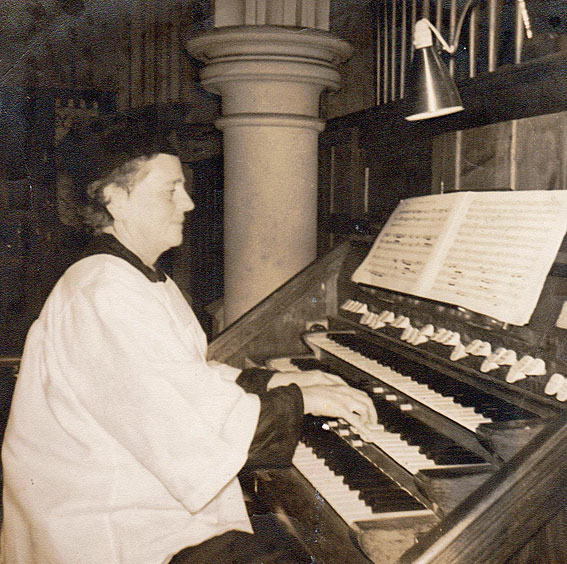
The console of 1914, now attached to the organ
in its new position in the chancel (photograph 1963).
Seated at the console is Constance Statham (Organist, 1955-1972)
[Photograph supplied by Ruth Mullan (November 2012)]
In 1974-75, the organ was enlarged and rebuilt with electro-pneumatic action by Whitehouse Bros. At the same time it was removed from the chamber it had occupied since 1929, and placed in a new gallery in the South (right) transept of the church to improve the egress of sound to the building. As in other work carried out by Whitehouse Bros at this time, the choice of additional stops (mixtures, trompette and schalmei) reflected strongly the stylistic influence of the enlargement by Hill, Norman & Beard at St John's Cathedral, Brisbane a few years earlier, although the addition of a new Pedal Open Wood 16ft simultaneously reflected the firm's more conservative practices.
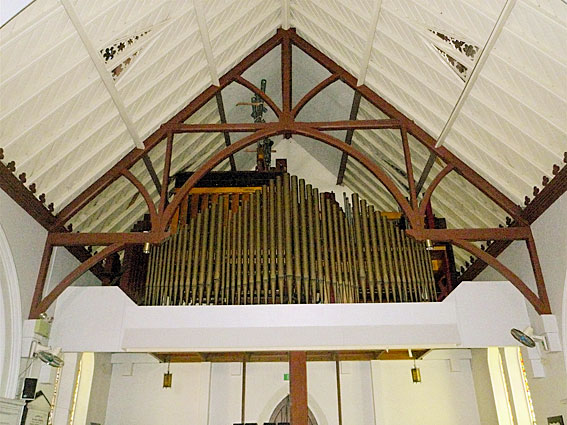
The organ as installed in 1975 in a new gallery in the South transept
[Photograph by Trevor Bunning (November 2011)]
Kevin Whitehouse, who was by this time manager of the firm, suffered ill health during the period this organ was being completed, and it was less than half operational by the time it was dedicated on Sunday 16 March 1975.30 The enlarged specification was as follows:
| GREAT Bourdon Open Diapason Violin Diapason Stopped Diapason Principal Chimney Flute Twelfth Fifteenth2 Mixture (19.22) Trompette |
16 8 8 8 4 4 2-2/3 2 II 8 |
A B |
[1860] [1860] [1929] [1914] [1860] [1860] [1860] [1860] [1975] [1975] |
| SWELL Horn Diapason Lieblich Gedact Salicional Voix Celeste [Ten.C] Gemshorn Suabe Flute Piccolo Mixture (22.26.29) Cornopean Clarion Oboe |
8 8 8 8 4 4 2 III 8 4 8 |
D D |
[1860] [1860; formerly 'Rohr flote'; bass octave 1897?] [1903] [1860; formerly 'Flute D'amour'] [1860; bass octave 1897?] [1975] [1903] [1975] [1897] [1975] [1897; bass octave 1929] |
CHOIR [enclosed except for Tuba] |
|||
| Dulciana Lieblich Gedact Koppel Flute Recorder Vox Humana (Ten.C) Tuba Oboe Schalmei |
8 8 4 2 8 8 8 |
C |
[1860; on Great until 1929] [1860; on Great until 1914] [1975] [1975] [1929] [1922] [1975] |
| PEDAL Open Wood Bourdon Echo Bourdon Violin Cello Bass Flute Octave Flute Schalmei |
16 16 16 8 8 4 4 |
E A B E E C |
[1975] [1914] [1860; restored 1975] [1929] [1975] [1975] [1975] |
| COUPLERS Swell to Great Swell to Choir Choir to Great Swell to Pedal Choir to Pedal Great to Pedal Swell Super Octave Swell Sub Octave Swell to Great Super Swell to Great Sub Choir Super Octave Choir Sub Octave |
|||
Detached draw-stop console
Swell tremulant [1975]
Choir tremulant [1975]
4 thumb pistons to Great Organ
4 thumb pistons to Swell Organ
3 thumb pistons to Choir Organ
4 toe pistons to Pedal Organ
Great and Pedal combinations coupled
Balanced swell pedal
Balanced choir pedal
Compass: 61/30
Electro-pneumatic action.31
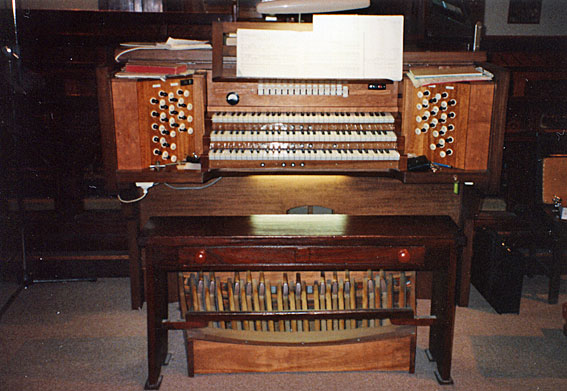
The new console supplied by Whitehouse Bros in 1975
[Photograph by Howard Baker (1990s)]
From the time the organ was completed in 1975, there were concerns about the voicing of some of the new stops, and about the blending of the additions with the older pipework.32 The organ was reported to have been vandalised in November 1991, and a radical rebuild was proposed with a view to restoring more of the character of the original instrument.33
W.J. Simon Pierce commenced a process of rebuilding the instrument in 1997-98 by repairing the Pedal Bourdon and chests, and making a new 12-stop Great slider soundboard to replace the 1914 cone-pallet soundboard. The new soundboard was initially operated with direct electric action, but designed to be converted to mechanical action.34 In 1999-2000, a new Seventeenth 1-3/5 stop was added to the Great, and the 1975 Great Mixture II was reconstituted to III ranks. A new Great Trumpet 8 was also added, replacing the 1975 Trompette,35 and the original Great Dulciana 8ft and Stopped Diapason 8ft were returned to the Great from the Choir.36
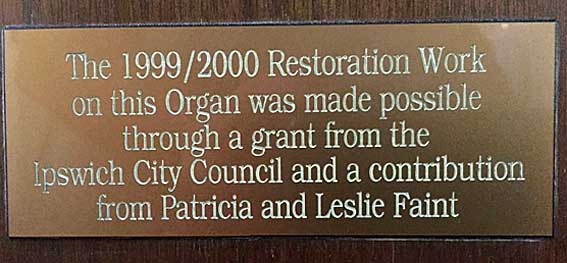
The 1999/2000 Donors' Plate
[Photograph by Peter Robinson (March 2015)]
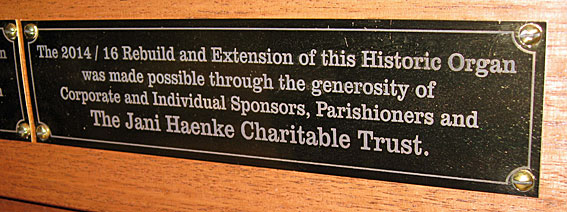
The 2014/2016 Donors' Plate
[Photograph by Geoffrey Cox (September 2016)]
The rebuilding of the instrument resumed in 2014 and concluded in 2016, with a return to mechanical action, a new console, new casework and the repositioning of the entire organ in the North (left) transept. The new Swell and Great soundboards, the rollerboards and much of the casework were made using a CNC machine or computerised router, which cuts out the wood to the exact dimensions of the plans.37
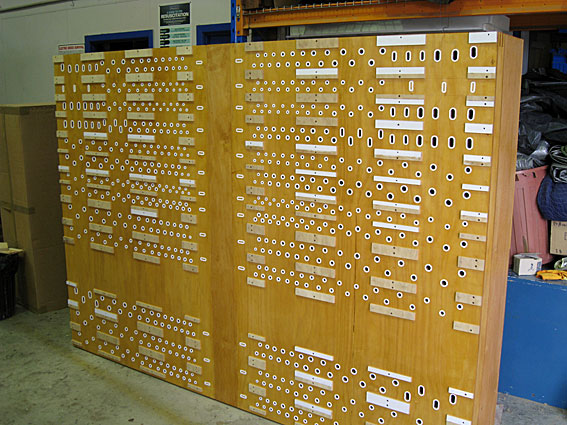
The new Swell soundboard in the factory,
made with the asistance of a CNC machine
[Photograph by Geoffrey Cox (July 2015)]
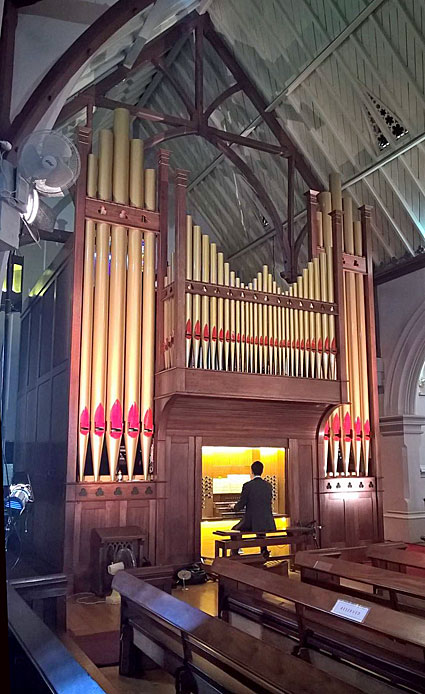
The rebuilt organ at St Paul's, Ipswich,
with Andrej Kouznetsov at the console
[Photograph by Pierce Pipe Organs (April 2016)]
The casework, which is of French-polished Tasmanian Oak, is entirely new and includes a central flat that replicates the 1860 Walker casework (see above), based on the cases of the 1873 Walker at St Phillip's, Church Hill, Sydney and the 1865 Walker at St Stephen's, Richmond, Melbourne. The stops from the original 1860 Great became the nucleus of the Choir on the enlarged instrument, which uses the 12-stop soundboard constructed in 1997-98. The four original 1860 Swell stops remain available on the Swell. The new Great and the Pedal divisions are on 4 inches of wind pressure, the Choir (former Great) and Swell on 3 inches of wind, while the Choir Tuba (on a separate electric-action chest) is on 14 inches of wind.38
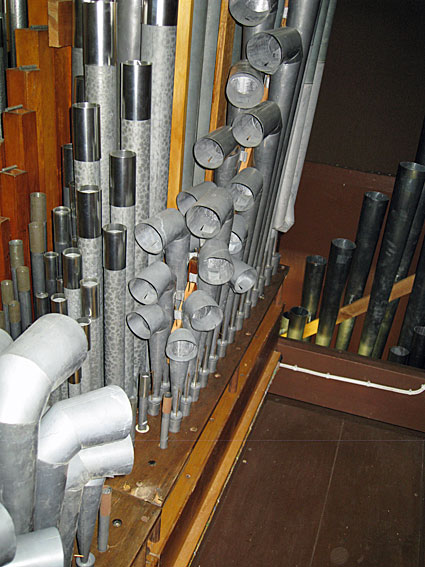
The 1922 Tuba, still on its original chest
[Photograph by Geoffrey Cox (September 2016)]
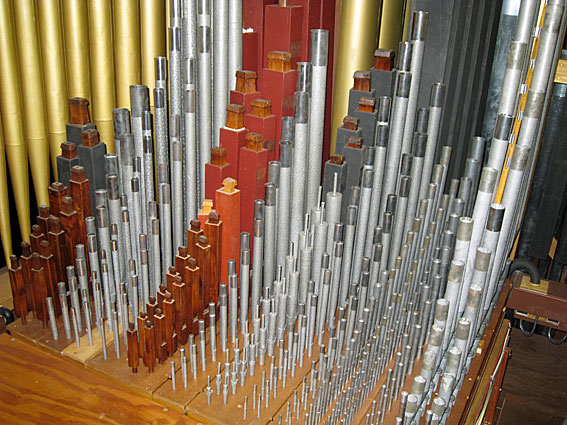
Pipework of the new Choir Organ
including that of the original Walker Great Organ
[Photograph by Geoffrey Cox (September 2016)]
Most of the Great pipework is new, although it incorporates some older stops, including two from the Great of the 1904 George Fincham and Son organ removed in the 1990s from the Grahame Memorial Uniting (Presbyterian) Church, Waverley, New South Wales. Another two stops from the Waverley organ have found their way to the Choir and Swell respectively.39 All but one of the stops added at Ipswich in 1897, 1903, 2014, 1922 and 1929 have been retained in the present instrument.40 Most of the stops added in 1975 have been discarded, although a few have been re-used in a variety of ways shown in the specification below.
| GREAT Double Diapason Open Diapason No 1 Open Diapason No 2 Clarabella Principal Harmonic Flute Quint Fifteenth Mixture Tromba |
|
A B |
[1904; Fincham, ex Waverley; new bottom octave] [1929-30; Ann Street Presbyterian 'Open No 1'] [1929; Great 'Violin Diapason'] [new 2016] [1904; Fincham, ex Waverley] [new 2016] [new 2016] [new 2016] [new 2016] [new 2016] |
|
| CHOIR Bourdon Open Diapason Stopped Diapason Gamba Dulciana [gvd bass] Principal Chimney Flute Twelfth Fifteenth Seventeenth Mixture (15.19.22) Clarinet Tuba |
16 8 8 8 8 4 4 2-2/3 2 1-3/5 III 8 8 |
C |
[incorporating the original Walker GREAT stops] [1860] [1860] [1860; on Choir Organ from 1914] [1904; Fincham, 'Dulciana' ex Waverley] [1860; on Choir Organ from 1929] [1860] [1860] [1860] [1860] [2000] [new 2016] [second-hand American, revoiced 2016] [1922; electric action] |
|
| SWELL Horn Diapason Rohr Flute Salicional Voix Celeste [Ten.C] Gemshorn Wald Flute Piccolo Sesquialtera Bassoon Trumpet Oboe Vox Humana [Ten.C] Clarion |
8 8 8 8 4 4 2 III 16 8 8 8 4 |
[1860] [1860; bass octave 1897?] [1903] [1860; formerly 'Flute D'amour'] [1860; bass octave 1897?] [1904; Fincham, 'Flute 4' ex Waverley] [1903] [1975; 'Mixture' re-scaled with new pipework 2016] [1975; Choir Oboe Schalmei] [1897; formerly Swell 'Cornopean'] [1897; bass octave 1929] [1929; ex Choir Organ] [1975; Great 'Trompette' revoiced] |
||
| PEDAL Open Diapason Violone Bourdon Echo Bourdon Bass Flute Violoncello Trombone Trumpet |
16 16 16 16 8 8 16 8 |
A C B |
[1975; Open Wood (Laukhuff)] [1904; Fincham, ex Waverley] [1914] [1860; Sub Bass Pedal] [1914; Rest Cartwright, London, ex Suva Cathedral, Fiji] [1929; Great Violin Diapason] [new 2016] [2000; Great Trumpet] |
|
| COUPLERS Swell to Great Swell to Choir Choir to Great Swell to Pedals Choir to Pedals Great to Pedals Swell Octave Swell Sub Octave |
[mechanical or electric] [mechanical or electric] [mechanical or electric] [mechanical] [mechanical] [mechanical] [electric] [electric] |
Attached draw-stop console
Compass: 56/30
Swell tremulant
6 thumb pistons to Great Organ
6 thumb pistons to Swell Organ
6 thumb pistons to Choir Organ
6 toe pistons to Pedal Organ
Swell to Great toe piston
Great to Pedal toe piston
8 General Pistons
Great and Pedal combinations coupled
Electric couplers (stop knob)
Balanced swell pedal (mechanical)
Solid state comb system
Sequencer
Electric stop action
Mechanical playing action.41
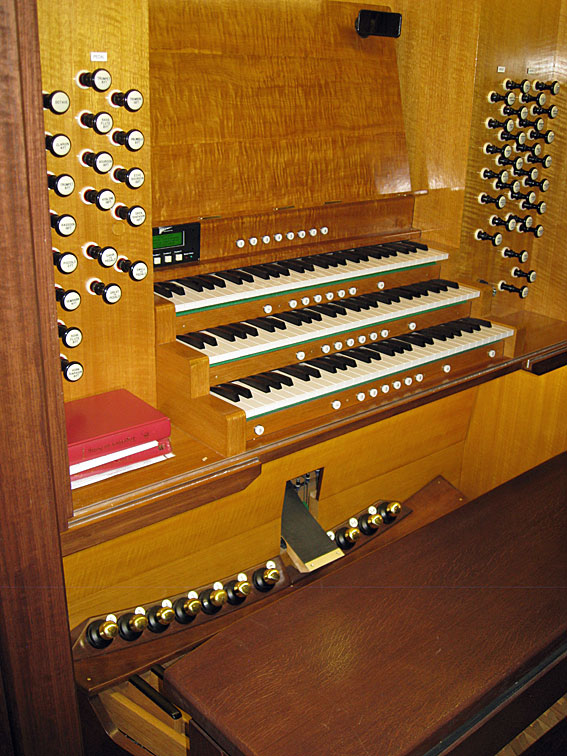
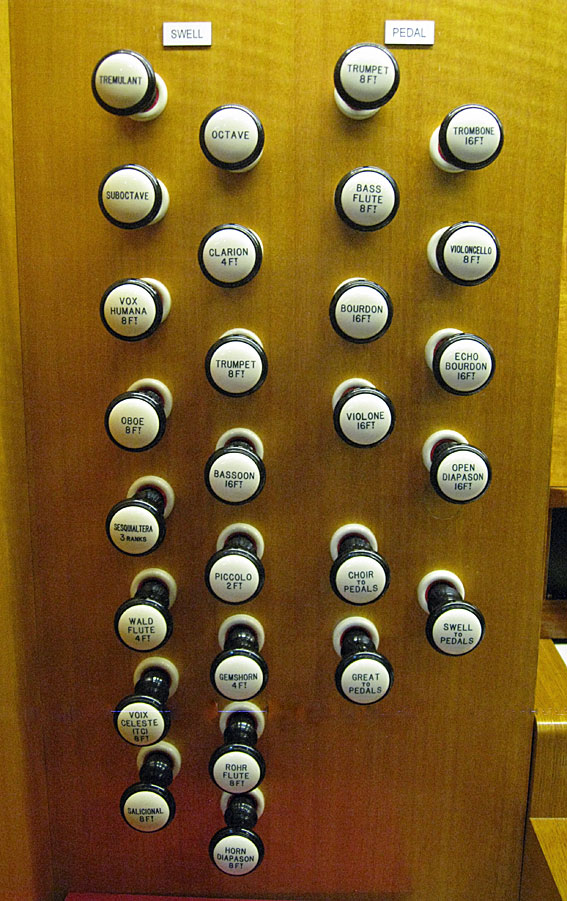
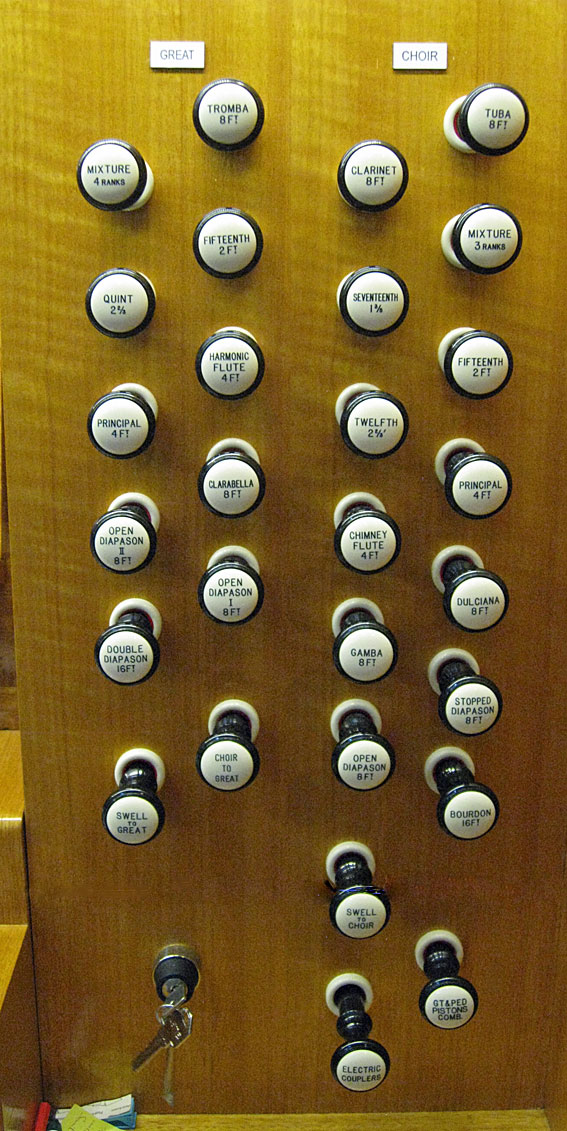
Console details
[Photographs by Geoffrey Cox (September 2016)]
Having been subjected to persistent enlargement, including major rebuilds in 1897, 1914, 1975 and 2016 respectively, the organ could hardly be described as having been 'restored' in the historic sense. The latest rebuild has nevertheless allowed the original 1860 Walker pipework to function with greater integrity than it had for the previous century. Although incorporating what might appear to be an unlikely assortment of components, the instrument as a whole now serves the enlarged building in a way that the 1860 Walker alone could not have done.
Only a part of the rebuilt organ was complete when it was formally opened and dedicated at a concert during the Ipswich Festival on Friday 8 April 2016, for which organists Andrej Kouznetsov, Phillip Gearing and Ross Windsor were joined by brass, percussion and massed choir.42 The instrument was completed some months later.
___________________________________________________________
1 Donald Watson & Judith McKay, Queensland Architects of the 19th Century: A Biographical Dictionary (Brisbane: Queensland Museum, 1994), pp. 18-19, 176, 202; The Church Standard (June 14, 1929), p. 665 - cited by Miss Ivy Roberts and supplied to G. Cox in personal communication (12 October 1974) from Bryan Capern (Organist, 1972-83).
2 The Sunday Mail Magazine (26 May 1974).
3 The Ipswich Herald (7 November 1859) - cited by Mr A.E. Roberts (Assistant Organist at St Paul's Church, 1898-1958) and supplied to G. Cox by Miss Ivy Roberts via Bryan J. Capern, 1974.
4 The Ipswich Herald (December 1859) - cited by Mr A.E. Roberts, op. cit.
5 Graeme Rushworth, Historic Organs of New South Wales: The Instruments, Their Makers and Players, 1791-1940 (Sydney: Hale & Iremonger, 1988), pp. 334, 340; see also: Andrew Grahame, 'St Paul's Ipswich: The Newcastle Connection,' The Organ Voice, vol. 19, no. 6 (June 1992), pp. 12-25, and Kelvin Hastie, 'The Walker Heritage in Australia Today,' OHTA News, vol. 8, no. 2 (April 1984), pp. 8-14.
6 J.W. Walker Ledger Book AA (1852-62), p. 368 - supplied to G. Cox by Alex Dingwall of J.W. Walker & Sons Ltd, July 1974.
7 St Paul's Monthly Paper (1 April 1908) - cited by Mr A.E. Roberts, op. cit.
8 J.W. Walker Ledger Book AA (1852-62), p. 368; The specification given by Ross Windsor (organist, 1984-1996) in Organ Society of Queensland Newsletter, vol. 17, no. 1 (August 1989), p. 5 is incorrect. It is corrected to some extent in The Organ Voice, vol. 19, no. 5 (April 1992), p. 15, but the details (apparently derived from The Organ, no. 218, vol. 55 (1976), p. 65) are not reproduced accurately: There was no stop on the Great named 'Sesquialtera'. Windsor adds information derived from the Diary of Sir Thomas Bell (24 September 1859) regarding spare slides for proposed additions, but there is no other evidence that the original organ included preparation for later additions.
9 Tom Appleton, 'The Pipe Organs of Central Ipswich - Part 1,' The Organ Voice, vol. 25, no. 1 (March 1999), p. 11.
10 The Moreton Bay Courier (Saturday 15 September 1860), p. 6.
11 Easter Report (1882) - cited by Miss Ivy Roberts - personal communication to G. Cox via Brian Capern, 12 October 1974.
12 Ross Windsor, 'Queensland's First Pipe Organ: The J.W. Walker Organ in St Paul's Anglican Church, Ipswich,' The Organ Voice, vol. 19, no. 5 (April 1992), p. 15.
13 The Courier (14 October 1863), p. 2 – 'from the Queensland Times of yesterday'.
14 The Queensland Times, Ipswich Herald and General Advertiser (11 September 1897), p. 4.
15 Easter Reports (1898, 1899 and 1904) – cited by Mr. A.E. Roberts, op. cit; see also The Brisbane Courier (7 May 1898), p. 8.
16 Tom Appleton, 'Organists of Ipswich,' The Organ Voice, vol. 28, no. 1 (March 2002), 12-13. 17 St Paul's Monthly Paper (February 1903) - cited by Mr A.E. Roberts, op. cit.
18 The Queensland Times, Ipswich Herald and General Advertiser (20 November 1897), p. 4.
19 Alternative datings that appeared in Organ Society of Queensland Newsletter, vol. 17, no. 1 (August 1989), p. 6, The Organ Voice, vol. 19, no. 5 (April 1992), p. 17, and The Organ Voice, vol. 25, no. 1 (March 1990), p. 11 did not take account of the 1897 rebuilding and enlargement of the instrument, or of any information contained in the parish Easter Reports or St Paul's Monthly Paper cited above.
20 Easter Report (1908) - cited by Mr A.E. Roberts, op. cit.
21 St Paul's Monthly Paper (1 May 1912) - op. cit.
22 The complete specification was given in St Paul's Monthly Paper (September 1, 1914) - cited by the late Mr A.E. Roberts, op. cit. Some details also appeared in The Church Chronicle (1 October 1914).
23 The Organ Voice, vol. 19, no. 5 (April 1992), p. 17.
24 Tom Appleton, 'The Pipe Organs of Central Ipswich - Part 1,' The Organ Voice, vol. 25, no. 1 (March 1999), p. 11.
25 St Paul's Monthly Paper (1 September 1922) - cited by Mr A.E. Roberts, op. cit.; Whitehouse Bros List gives the date as July 1921.
26 Easter Report (1928) - cited by Mr A.E. Roberts, op. cit.
27 Easter Report (1929) - cited by Mr A.E. Roberts, op. cit.; Whitehouse Bros Ledger (1922-1940), p. 446.
28 Specification noted by G. Cox, 1973.
29 Whitehouse Bros List & personal communication to G. Cox from Kevin Whitehouse, c.1974.
30 Personal communications to G. Cox from Bryan Capern, 14 March, 6 May & 26 May 1975.
31 The Organ Voice, vol. 19, no. 5 (April 1992), p. 28. Details also supplied to G. Cox by Kevin Whitehouse & Bryan Capern, 1974-75, and checked against specification partially recorded in Victorian Organ Journal, vol. 4, no. 8 (June 1976), p. 13. Dates derive from previous documentation presented here.
32 Organ Society of Queensland Newsletter, vol. 17, no. 1 (August 1989), p. 8.
33 The Organ Voice, vol. 19, no. 3 (December 1991), p. 56.
34 The Organ Voice, vol. 24, no. 1 (March 1998), p. 31.
35 The Organ Voice, vol. 25, no. 4 (December 1999), pp. 27-28 & back cover; The Organ Voice, vol. 26, no. 1 (March 2000), pp. 27-28 & back cover; The Organ Voice, vol. 26, no. 2 (June 2000), back cover; OHTA News, vol. [24], no. 3 (July 2000), p. 7.
36 Personal communication to G. Cox from Simon Pierce, January 2003.
37 Simon Pierce, 'New Work in Queensland and New Zealand,' Organ Australia (Winter 2015), pp. 41-43.
38 Personal communication to G. Cox from Simon Pierce, September 2016. See also: Simon Pierce, 'A Restoration, A Rebuilding or a New Organ?' Organ Australia, edition 3/2016, pp. 34-37.
39 Most of the Swell pipework and the Swell soundboard from the 1904 Fincham organ at Waverley were used in 2014 to enlarge the organ at St Peter's Anglican Church, Southport. The Great Claribel 8ft from Waverley was added in 2007 to the organ at St Augustine's Anglican Church, Hamilton.
40 The Great Stop Diapason dating from 1914 at Ipswich was added in 2015 to the organ at Holy Trinity Anglican Church, Mackay.
41 Specification noted by G. Cox, September 2016, incorporating details derived from the documentation above, and details supplied by Simon Pierce to G. Cox, July 2015 and January 2016.
42 Personal communication to G. Cox from Peter Robinson, May 2016.